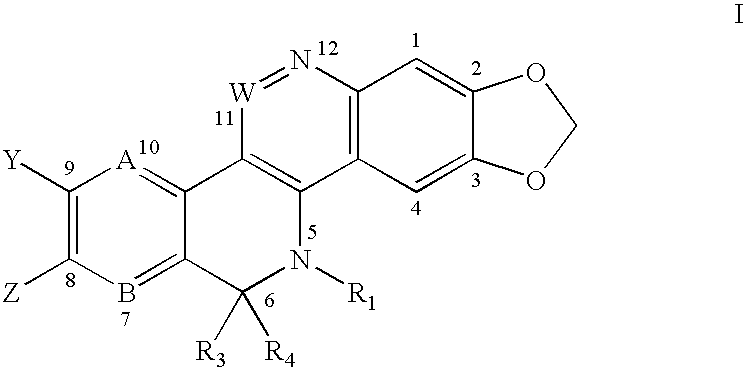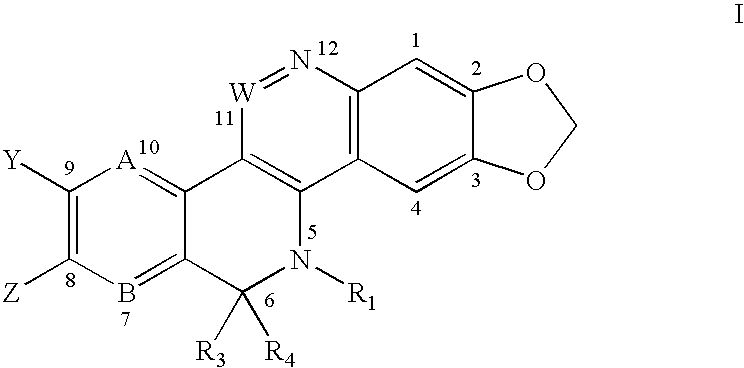Solubilized topoisomerase poisons
a topoisomerase and poison technology, applied in the field of dnatopoisomerases, can solve the problems of limited usefulness of compounds, and achieve the effects of modulating topoisomerase activity, and inhibiting cancer cell growth
- Summary
- Abstract
- Description
- Claims
- Application Information
AI Technical Summary
Benefits of technology
Problems solved by technology
Method used
Image
Examples
example 1
11,12-dihydro-2,3-dimethoxy-8,9-methylenedioxy-11-[2-(dimethylamino)ethyll-5,6,11-triazachrysen-12-one (5). A mixture of 4-N-(2-Dimethylaminoethyl)-N-(2-bromo-4,5-dimethoxybenzoyl)amine-6,7-methylenedioxycinnoline (4,220 mg, 0.40 mmol), Pd(OAc)2 (18.0 mg, 0.08 mmol), P(o-tolyl)3 (48.8 mg, 0.16 mmol), and silver carbonate (225 mg, 0.80 mmol) were heated to reflux in DMF (12 mL) and stirred under nitrogen for 75 minutes. The reaction mixture was cooled to room temperature, diluted with chloroform and filtered though a bed of celite. The solvent was removed under reduced pressure and the resulting residue was chromatographed on silica gel using 95:5 chloroform:methanol to give the title compound (60 mg) in 36% yield; 1H NMR (CDCl3) δ 2.42(s, 6H), 3.04(t, 2H, J=7.2 Hz), 4.08(s, 3H), 4.17(s, 3H), 4.64(t, 2H, J=7.2 Hz), 6.25(s, 2H), 7.81(s, 1H), 7.84(s, 1H), 8.07(s, 1H), 8.65(s, 1H); 13C NMR (CDCl3) δ 45.9, 47.4, 56.4, 56.7, 57.7, 99.4, 102.8, 104.3, 106.6, 107.9, 113.7, 119.6, 129.1, 13...
examples 2-6
The representative compounds of the invention at Examples 2-6 were prepared using the following general procedure from the intermediates prepared in the correspondingly numbered sub-parts a below.
A mixture of the requisite 4-amino-6,7-methylenedioxycinnoline o-iodobenzamide derivative (1.0 mmol equiv.), Pd(OAc)2 (0.2 mmol equiv.), P(o-tolyl)3 (0.4 mmol equiv.), and Ag2CO3 (2.0 mmol equiv) was heated to reflux in DMF (30 mL per mmol equiv.) with stirring. The reaction mixture was allowed to cool to room temperature, diluted with CHCl3, and filtered through Celite. The sicciate was extensively washed with 10% CH3OH in CHCl3. The filtrate was concentrated in vacuo and the residue chromatographed on silica gel using chloroform:methanol to provide the title compound.
EXAMPLE 2
2,3-Dimethoxy-8,9-methylenedioxy-11-[(2-diethylamino)ethyl]-11H-5,6,11-triaza-chrysen-12-one: Prepared from N-(6,7-Methylenedioxycinnolin-4-yl)-N-(N,N-diethylaminoethyl)-2-iodo-4,5-dimethoxybenzamide (578 mg, 1...
examples 2
The intermediate 4-amino-6,7-dimethoxyquinoline derivatives used in Examples 2.a-6.a. were prepared using the following general procedure.
The appropriate primary amine (1.0 mol equiv.) added with stirring to 4-Chloro-6,7-methylenedioxycinnoline (see Example 1 above). The reaction was then allowed to stir at 100° C. for several hours, and the phenol removed by Kugelrohr distillation under reduced pressure. The residue was partitioned between CHCl3 and 10% NaOH. The aqueous layer was repeatedly separated with CHCl3. All of the CHCl3 solutions (initial partition and extracts) were combined and dried (MgSO4).
PUM
| Property | Measurement | Unit |
|---|---|---|
| Composition | aaaaa | aaaaa |
| Acidity | aaaaa | aaaaa |
| Pharmaceutically acceptable | aaaaa | aaaaa |
Abstract
Description
Claims
Application Information
 Login to View More
Login to View More - R&D
- Intellectual Property
- Life Sciences
- Materials
- Tech Scout
- Unparalleled Data Quality
- Higher Quality Content
- 60% Fewer Hallucinations
Browse by: Latest US Patents, China's latest patents, Technical Efficacy Thesaurus, Application Domain, Technology Topic, Popular Technical Reports.
© 2025 PatSnap. All rights reserved.Legal|Privacy policy|Modern Slavery Act Transparency Statement|Sitemap|About US| Contact US: help@patsnap.com



